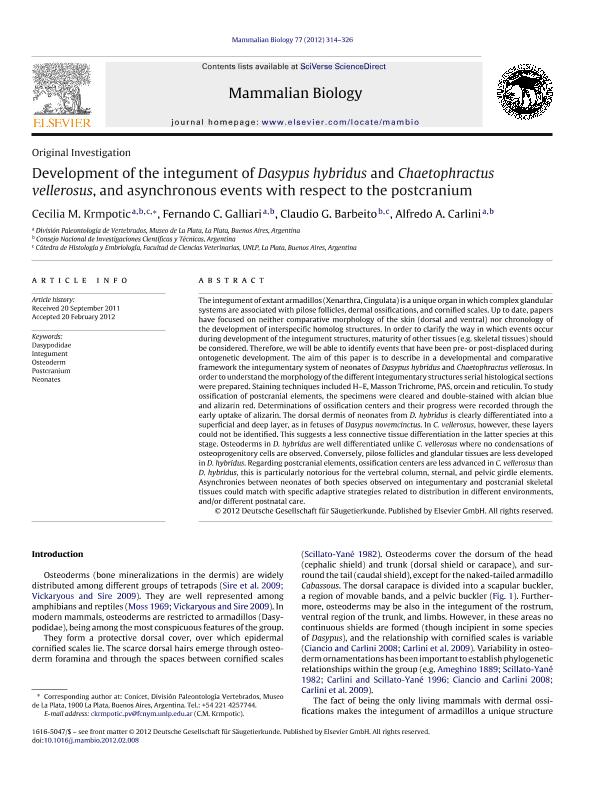Artículo
Development of the integument of Dasypus hybridus and Chaetophractus vellerosus, and asynchronous events with respect to the postcranium
Krmpotic, Cecilia Mariana ; Galliari, Fernando Carlos
; Galliari, Fernando Carlos ; Barbeito, Claudio Gustavo
; Barbeito, Claudio Gustavo ; Carlini, Alfredo Armando
; Carlini, Alfredo Armando
 ; Galliari, Fernando Carlos
; Galliari, Fernando Carlos ; Barbeito, Claudio Gustavo
; Barbeito, Claudio Gustavo ; Carlini, Alfredo Armando
; Carlini, Alfredo Armando
Fecha de publicación:
09/2012
Editorial:
Elsevier Gmbh
Revista:
Mammalian Biology
ISSN:
1616-5047
Idioma:
Inglés
Tipo de recurso:
Artículo publicado
Clasificación temática:
Resumen
The integument of extant armadillos (Xenarthra, Cingulata) is a unique organ in which complex glandular systems are associated with pilose follicles, dermal ossifications, and cornified scales. Up to date, papers have focused on neither comparative morphology of the skin (dorsal and ventral) nor chronology of the development of interspecific homolog structures. In order to clarify the way in which events occur during development of the integument structures, maturity of other tissues (e.g. skeletal tissues) should be considered. Therefore, we will be able to identify events that have been pre- or post-displaced during ontogenetic development. The aim of this paper is to describe in a developmental and comparative framework the integumentary system of neonates of Dasypus hybridus and Chaetophractus vellerosus. In order to understand the morphology of the different integumentary structures serial histological sections were prepared. Staining techniques included H-E, Masson Trichrome, PAS, orcein and reticulin. To study ossification of postcranial elements, the specimens were cleared and double-stained with alcian blue and alizarin red. Determinations of ossification centers and their progress were recorded through the early uptake of alizarin. The dorsal dermis of neonates from D. hybridus is clearly differentiated into a superficial and deep layer, as in fetuses of Dasypus novemcinctus. In C. vellerosus, however, these layers could not be identified. This suggests a less connective tissue differentiation in the latter species at this stage. Osteoderms in D. hybridus are well differentiated unlike C. vellerosus where no condensations of osteoprogenitory cells are observed. Conversely, pilose follicles and glandular tissues are less developed in D. hybridus. Regarding postcranial elements, ossification centers are less advanced in C. vellerosus than D. hybridus, this is particularly notorious for the vertebral column, sternal, and pelvic girdle elements. Asynchronies between neonates of both species observed on integumentary and postcranial skeletal tissues could match with specific adaptive strategies related to distribution in different environments, and/or different postnatal care.
Palabras clave:
Dasypodidae
,
Integument
,
Neonates
,
Osteoderm
,
Postcranium
Archivos asociados
Licencia
Identificadores
Colecciones
Articulos(CCT - LA PLATA)
Articulos de CTRO.CIENTIFICO TECNOL.CONICET - LA PLATA
Articulos de CTRO.CIENTIFICO TECNOL.CONICET - LA PLATA
Citación
Krmpotic, Cecilia Mariana; Galliari, Fernando Carlos; Barbeito, Claudio Gustavo; Carlini, Alfredo Armando; Development of the integument of Dasypus hybridus and Chaetophractus vellerosus, and asynchronous events with respect to the postcranium; Elsevier Gmbh; Mammalian Biology; 77; 5; 9-2012; 314-326
Compartir
Altmétricas



